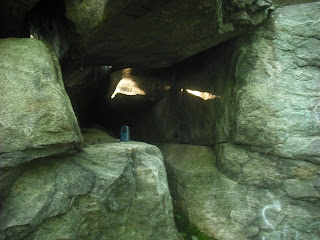At the East unit, the Tanke Verde trail climbs into the pine forests of the Catalina mountain.
The southwest has many of the same structures we have in the northeast, and they are much less disrupted by farming and housing development. The southwest also has something the northeast lacks: poisonous snakes. Watch your step!
Luckily, this one is harmless.
Balanced rocks near the Tanke Verde trail.
Here at the trailhead, an effigy and a propped boulder stand on an outcrop, surrounded by prickly pear and ocotillo bushes. The effigy looks a little like a bird.The long axis of the propped boulder is parallel to the trail. Perhaps it once meant "this way".
Now we can go the the west unit. The big attraction there is Signal Hill, a huge pile of boulders covered with geometric petroglyphs.
Many of these are spirals
Some are animals
There didn't seem to be any alignment with any other features. Perhaps this rocky hill was simply a convenient place to carve petroglyphs.































